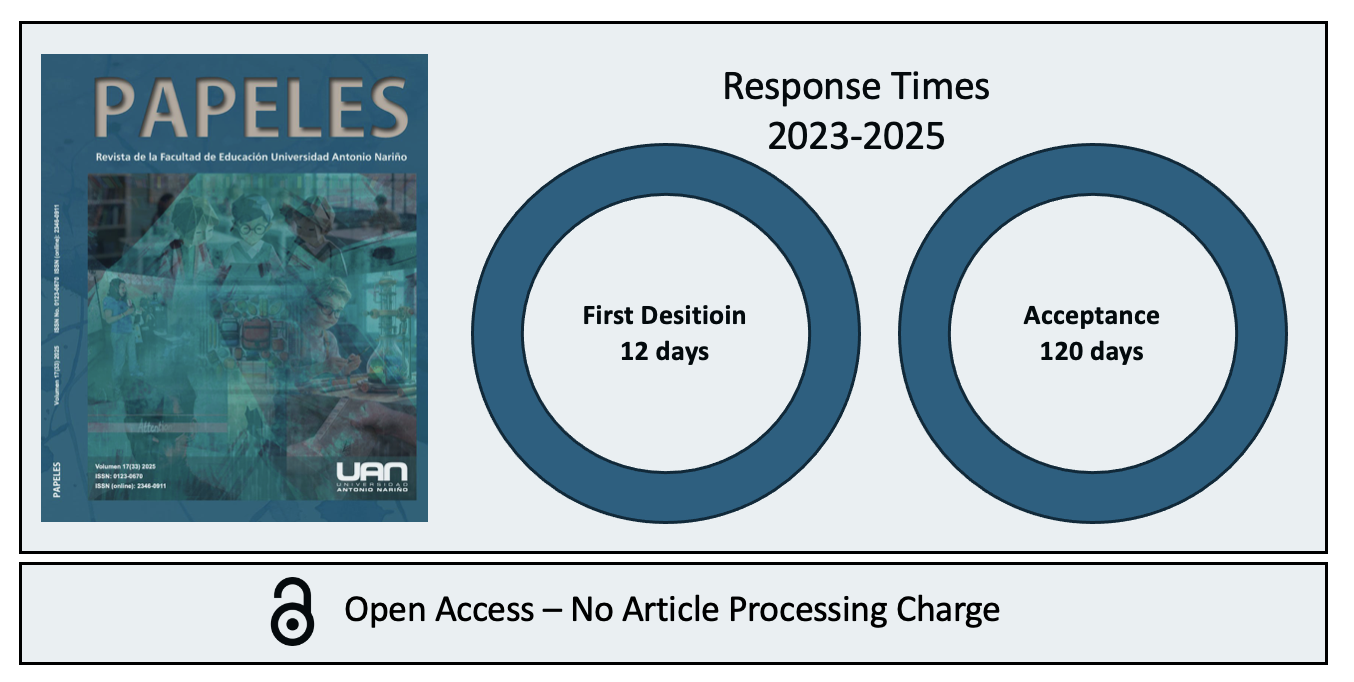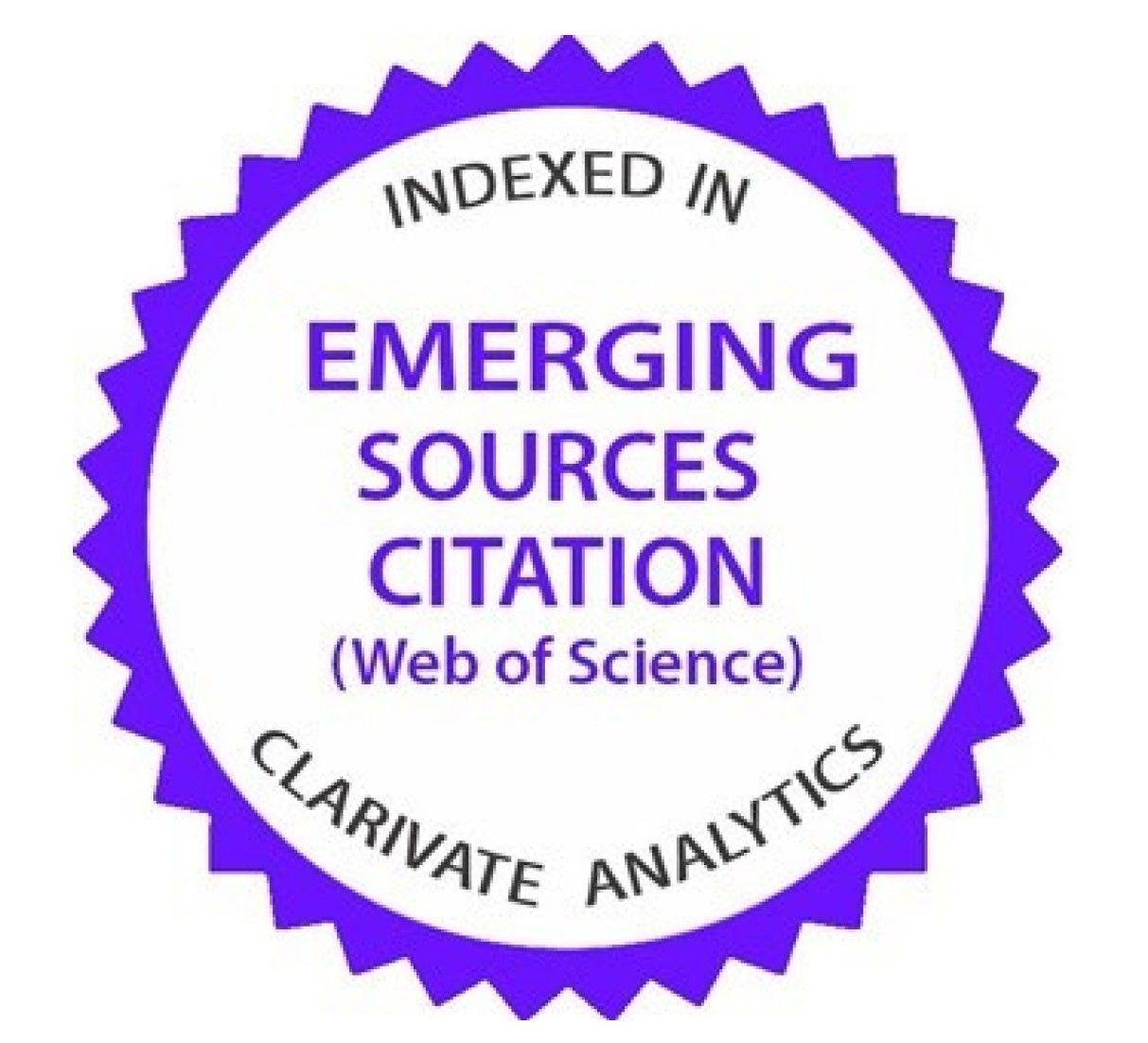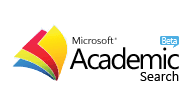Una revisión crítica acerca del desarrollo y de la implementación de libros de texto de inglés contextualizados e institucionalizados
DOI:
https://doi.org/10.54104/papeles.v11n21.581Keywords:
desarrollo de materiales, libro de texto de inglés institucional, inglés con propósitos generales, inglés con propósitos específicos, estrategias de aprendizaje, modelo dualAbstract
This paper shares a reflection based on a qualitative research case study that looked into the pertinence of developing and implementing a six in-house strategy-based English textbook series that combines English for General Purposes (EGP) and English for Specific Purposes (ESP) among undergraduates in the dual model at a private university. The
study was conducted with twelve undergraduates from four majors, three English teachers and the coordinator of the Foreign Language Centre of this university, who performed the role of the researcher and materials developer. The objectives underlying this work were to develop and implement in-house strategy-based textbooks and to characterise
students and teachers’ perceptions regarding their pertinence in the dual model. Theinformation-compiling instruments used in the study were a focus-group interview (to collect students’ perspectives on the relevance of merging EGP and ESP content in an English series), and field notes from the English teachers (to gather their perspectives as participants-observers of the process). After analysing the collected data, the findings of the study revealed that (a) there was an increasing awareness of English as the global language to foster academic development, professional performance and work opportunities; (b) the EGP and ESP blending was regarded as the ideal complement for dual model programmes; and (c) developing and implementing contextualised in-house materials were deemed to be a congratulatory effort in the quest of helping students learn. Developing and implementing in-house materials, in an English Programme for undergraduates in
the dual model narrowed the gap between the purpose of the theory and the real needs of the business apprenticeship. Despite the achieved results regarding the pertinence of the contextualised in-house EFL textbooks, an unusual academic decision, that seemed subtly supported by several EFL teachers, banned the use of the series that had served as a learning awareness-raising pedagogical resource for undergraduates under the dual
model of a private university.
Downloads
References
(1) Aebersold, J., & Lee, M. (2002). From reader to reading teacher. New York, NY: Cambridge University Press.
(2) Álvarez-Valencia, J. A. (2008). Educational commercialism: ¿Is it overtaking EFL in Colombia? ASOCOPI Newsletter, p. 7.
(3) Allwright, R. L. (1981). What do we want teaching materials for? ELT Journal, 36(1), 5–18.
(4) Alzate, M., Arbeláez, M., Gallón, H., Gómez, M., & Romero, F. (2005). El texto escolar y las mediaciones didácticas y cognitivas. Informe del proyecto Uso de los libros de texto de ciencias sociales e historia en grado 7° de la educación básica secundaria en Colombia. Pereira: Colciencias-Universidad Tecnológica de Pereira.
(5) Bedwell, C. (2012). A suggested writing process for in-house materials development. English Language Teaching World Online, 4, 1-9.
(6) Belcher, D. (2004). Trends in teaching English for specific purposes. Annual Review of Applied Linguistics, 24, 165-186.
(7) Belcher, D. (2006). English for specific purposes: Teaching to perceive needs and imagined futures in worlds of work, study and everyday life. TESOL Quarterly, 40(1), 133-156.
(8) Bell, J. (2005). Doing your research project. A guide for first- time researchers in education and social science. Berkshire, UK: Open University Press.
(9) Brunton, M. (2009). An account of ESP–with possible future directions. English for Specific Purposes, 8(3), 1-15.
(10) Burns, A (1999). Collaborative action research for English language teachers. New York, NY: Cambridge University Press.
(11) Canagarajah, S. (2005). Introduction. In S. Canagarajah (Ed.). Reclaiming the local in language policy and practice (xiii–xxx). Mahwah, NJ: Lawrence Erlbaum Associates.
(12) Canagarajah, S. (1999). Resisting linguistic imperialism in English teaching. Oxford, UK: Oxford University Press.
(13) Carter, R. (1998) Orders of reality: CANCODE, communication and culture. ELT Journal 52(1), 3-56.
(14) Castañeda, H., & Rico, C. (2015). Rasgos característicos de la enseñanza en Colombia en el área de inglés como lengua extranjera. Análisis de las propuestas pedagógicas presentadas al premio Compartir al Maestro. Bogotá, Colombia: Fundación Compartir.
(15) Castro, P., & Sercu. L. (2005). Objectives of foreign language teaching and culture teaching time. In M. Byram & A. Phipps. (Eds.). Languages for international communication and education (pp. 19-38). Trowbridge, Wiltshire, UK: Cromwell Press Ltd.
(16) Chamot, A., & O’Malley, J.M. (1999). CALLA handbook, implementing the cognitive academic language learning approach. Nueva York, NY: Addison-Wesley Publishing Company.
(17) Chamot, A. U. (2004). Issues in language learning strategy research and teaching. Electronic Journal of Foreign Language Teaching 1(1), pp. 14-26
(18) Clarke, D.F. (1989). Materials adaptation: why leave it all to the teachers? ELT journal 43 (2): 133-41.
(19) Corbin, J., & Strauss, A. (2008). Basics of qualitative research: Techniques and procedures for developing grounded theory. Thousand Oaks, CA: Sage Publications.
(20) Davcheva, L., & Sercu, L., (2005). Culture in foreign language teaching materials. In L Sercu (Comp). Foreign language teachers and intercultural competence. An international investigation (pp. 76-90). Clevedon, UK: Multilingual Matters Ltd.
(21) de Mejía, A. M. (2006). Bilingual education in Colombia: Towards a recognition of languages, cultures and identities. Colombian Applied Linguistics Journal, (8), 152-168.
(22) Freire, P. (1998). Pedagogía de la autonomía. México D.F., México: Siglo XXI Editores.
(23) Gilmore, A. (2007). Authentic materials and authenticity in foreign language learning. Language Teaching 40 (2), 97–118.
(24) Giroux, H., & Simon, R. (1988). Schooling, popular culture, and a pedagogy of possibility. Journal of Education, 170(1), 9-26.
(25) Giroux, H. (1997). Pedagogy and the politics of hope: Theory, culture and schooling. Oxford, UK: Westview Press.
(26) Giroux, H. A. (2001). Public spaces, private lives: Beyond the culture of cynicism. New York, NY: Roman & Littlefield.
(27) Giroux, H. (2012). The disappearance of public intellectuals. En Counterpunch. Petrolia, California. Retrieved from http://www.counterpunch.org/2012/10/08/the-disappearance-of-public-intellectuals/
(28) Graves, K. (1997). Teachers as course developers. New York, NY: Cambridge University Press.
(29) Gray, J. (2010). The Construction of English: Culture, Consumerism and Promotion in the ELT Global Coursebook. Basingstoke, UK: Palgrave Macmillan.
(30) Gray J. (2013). Critical perspectives on language teaching materials. Hampshire, UK: Palgrave Macmillan Publishers Limited.
(31) González, A. (2006). On materials use training in EFL teacher education: Some reflections. PROFILE: Issues in Teachers’ Professional Development, 7, 101-115. Bogotá: Universidad Nacional e Colombia.
(32) Harwood, N. (2010). Issues in materials development and design. In B. Tomlinson (Ed.), English language teaching materials: Theory and practice. (pp.3-23). New York, NY: Cambridge University Press.
(33) Hatch, J. A. (2002). Doing qualitative research in education settings. Albany, NY: State University of New York Press.
(34) Howard, J., & Major, J. (2005). Guidelines for designing effective English language teaching materials. The TESOLANZ Journal, 12, 50-58.
(35) Howatt, A.P.R., & Widdowson, H.G. (2004). A history of English language teaching. Oxford, UK: Oxford University Press.
(36) Hutchinson, T., & Torres, E. (1994). The textbook as agent of change. ELT Journal, 48(4), 315–328.
(37) Hutchinson, T., & Waters, A. (1987). English for Specific Purposes: A learning-centered approach. NY: Cambridge.
(38) Hitchcock & Hughes (1995). Research and the teacher: a qualitative introduction to school-based research. Glasgow, UK: Cambridge University Press.
(39) Hopkins D. (1995). A teacher's guide to classroom research. Buckingham, UK: Open University
(40) Jolly, D., & Bolitho, R. (1998). The process of materials writing. In Tomlinson, B. (Ed.), Materials Development for Language Teaching. (pp. 90-115). Cambridge, UK: Cambridge University Press.
(41) Kincheloe, J. L. (1993). Toward a critical politics of teacher thinking: Mapping the postmodern. Westport, CT: Bergin & Garvey.
(42) Kramsch, C. (1993). Context and culture in language teaching. Oxford, UK: Oxford University.
(43) Kumaravadivelu, B. (1994). The post-method condition: (E)merging strategies for second/foreign language teaching. TESOL Quarterly, 28(1), 27- 48.
(44) Kumaravadivelu, B. (2014). The Decolonial Option in English Teaching. Can the subaltern act? TESOL Quarterly, 14(1), 66-85.
(45) Littlejohn, A. (2012). Language teaching materials and the (Very) Big Picture. Electronic Journal of Foreign Language Teaching. 9(1), 283–297.
(46) Mc Donough, J., & Shaw, C. (2003). Materials and methods in ELT: A teacher's guide. Malden, MA: Blackwell Publishing.
(47) McDonough, J., Shaw, C., & Masuhara, H. (2013). Materials and methods in ELT: A teacher's guide (3rd Ed.). Oxford, UK: John Wiley & Sons.
(48) Maly, A. (1998). Squaring the circle-reconciling materials as constraints with material as empowerment. In B. Tomlinson, (Ed.), English language learning materials: A critical review (pp.183-198). London: Continuum.
(49) Masuhara, H. (1998). What do teachers really want from coursebooks? In Tomlinson, B. (Ed.), Materials Development for Language Teaching. (pp. 239-260). Cambridge, UK: Cambridge University Press.
(50) Maxwell, J. A. (2008). Designing a qualitative study. The SAGE handbook of applied social research methods, 2, 214-253.
(51) Merriam, S. B. (2009). Qualitative research: a guide to design and implementation. San Francisco, CA: John Wiley & Sons.
(52) Ministerio de Educación Nacional [MEN]. (1994). Ley General de Educación (Ley 115 del 8 de febrero, de 1994) Retrieved from http://www.mineducacion.gov.co/ 1621/articles-85906_archivo_pdf.pdf
(53) Ministerio de Educación, Cultura y Deporte (2002). Marco común de referencia para la enseñanza, aprendizaje y evaluación de las lenguas. Madrid, España: Artes Gráficas Fernández Ciudad S.L.
(54) Ministerio de Educación Nacional [MEN] (2004). El programa nacional de bilingüismo. Retrieved from: www.mineducacion.gob.co
(55) Ministerio de Educación Nacional [MEN] (2006). Estándares básicos de competencias en lenguas extranjeras: inglés. Bogotá, Colombia: Imprenta Nacional.
(56) Ministerio de Educación Nacional [MEN]. (2007). Plan Nacional Decenal de Educación 2006-2016. Bogotá: Colombia. Imprenta Nacional.
(57) Ministerio de Educación Nacional [MEN]. (2013). Ley 1651 de Bilingüismo. Retrieved from https://www.funcionpublica.gov.co/eva/gestornormativo/norma.php?i=53770
(58) Ministerio de Educación Nacional [MEN] (2014). Colombia Very Well! Programa Nacional de Inglés 2015- 2025. Retrieved from https://www.mineducacion.gov.co/1759/articles-343837_Programa_Nacional_Ingles.pdf
(59) Montijano, Del P. (2014). Textbook use training in EFL teacher education. Utrecht Studies in Language & Communication, 27, 267-286.
(60) Mohseni, M. (2008). On the relationship between ESP & EGP: A general perspective. English for Specific Purposes World Issue. 7(17), 1-11
(61) Núñez A. (2009) On the Road Student’s Book 1 for Beginners. Bogotá, Colombia: Fundación Universitaria Empresarial de la Cámara de Comercio de Bogotá Uniempresarial.
(62) Núñez, A. (2010a) The teaching of English within the theory-practice alternance model. In: Innovación y Competitividad Jornada de Investigación, (pp. 32-54). Dirección de Investigaciones y Estudios Empresariales de la Cámara de Comercio de Bogotá Uniempresarial.
(63) Núñez, A. (2010b) On the Road Student’s Book 2 for Elementary A. Bogotá, Colombia: Fundación Universitaria Empresarial de la Cámara de Comercio de Bogotá Uniempresarial.
(64) Núñez, A. (2010c) Economics Essentials. Bogotá, Colombia: Fundación Universitaria Empresarial de la Cámara de Comercio de Bogotá Uniempresarial.
(65) Núñez, A. (2011) On the Road Student’s Book 3 for Elementary B. Bogotá, Colombia: Fundación Universitaria Empresarial de la Cámara de Comercio de Bogotá Uniempresarial.
(66) Núñez-Pardo, A. (2018a). The English textbook. Tensions from an intercultural perspective. GiST Education and Learning Research Journal,17(2), 230-259.
(67) Núñez, A. (2018b). Critical interculturality to disrupt coloniality in the English textbook. Revista Virtual Cuestiones Educativas, septiembre (1-9). Bogotá, Colombia: Universidad Externado de Colombia.
(68) Núñez, A., Parga, F., & Toquica, M. (2011) On the Road Student’s Book 5 for Pre-Intermediate B. Bogotá, Colombia: Fundación Universitaria Empresarial de la Cámara de Comercio de Bogotá Uniempresarial.
(69) Núñez, A., Pineda, C., & Téllez, M. (2004). Key aspects for developing your instructional materials. PROFILE: Issues in Teachers’ Professional Development, 5, 128-139. Bogotá: Universidad Nacional de Colombia.
(70) Núñez, A., & Quiroga, C. (2011) On the Road Student’s Book 4 for Pre-intermediate A. Bogotá, Colombia: Fundación Universitaria Empresarial de la Cámara de Comercio de Bogotá Uniempresarial.
(71) Núñez, A., Ramos, B., & Téllez, M. F. (2006). Reflexión en el contexto educativo: hacia la toma de decisiones en el aula [Reflection in the educational context: Towards decision making in the classroom]. @puntes Cont@bles, 11, 111-115.
(72) Núñez, A., & Téllez, M. (2008). Meeting students’ needs. Enletawa Journal, 1, 65-68. Tunja, Boyacá: Universidad Pedagógica y Tecnológica de Colombia.
(73) Núñez, A., & Téllez, M. F. (2009). ELT Materials: The Key to Fostering Effective Teaching and Learning Settings. PROFILE: Issues in Teachers’ Professional Development, 11(2), 173-186.
(74) Núñez, A., & Téllez, M. F. (2015). Reflection on teachers’ personal and professional growth through a materials development seminar. HOW, 22(2), 54-74.
(75) Núñez, A., & Téllez, M.F. (2018). The argumentative competence through in-class debates. En A. Núñez, M.F. Téllez, & J. Gómez (Eds.) (pp. 19-103). Teacher-developed materials for language teaching and learning. Departamento de Publicaciones Universidad Externado de Colombia.
(76) Núñez-Pardo, A., & Téllez-Téllez, M. (2020). Tracing the cultural component in teacher-generated EFL materials. (in press). In: A, Núñez-Pardo & M. F. Téllez (Eds.). Research on teacher-generated materials for language learning. Bogotá, Colombia: Departamento de Publicaciones Universidad Externado de Colombia.
(77) Núñez, A., Téllez, M. F., & Castellanos, J. (2013). Proposal for the research line materials development and didactics (Ascribed to the Research Group: Critical Pedagogy and Didactics for Social Transformation). Universidad Externado de Colombia, Bogotá.
(78) Núñez, A., Téllez, M., & J. Castellanos (2012) A framework for materials development: A path for in-service teachers to build up the instructional design of their research projects. In A. Núñez, M. Téllez & J. Castellanos (Eds.). Teacher research on English didactics issues. (pp.17-38). Bogotá, Colombia: Departamento de Publicaciones Universidad Externado de Colombia.
(79) Núñez, A., Téllez, M. F., & Castellanos, J. (2017a). Materials development for teachers’ professional growth. In A. Núñez, M. F. Téllez, & J. Castellanos (Eds.), Materials for the learning of English and teachers’ professional growth. (pp. 19-68). Bogotá, Colombia: Departamento de Publicaciones Universidad Externado de Colombia.
(80) Núñez, A., Téllez, M. F., & Castellanos, J. (2017b). Teacher–Developed materials in a Master’s programme in education with emphasis on English didactics. In A. Núñez, M. F. Téllez, & J. Castellanos (Eds.), The role of teacher- developed materials in fostering English language skills. (pp. 13-56). Bogotá, Colombia: Departamento de Publicaciones Universidad Externado de Colombia.
(81) Núñez, A., Téllez, M. F., Castellanos, J., & Ramos, B. (2009). A practical materials development guide for EFL pre-service, novice, and in-service teachers. Bogotá, Colombia: Universidad Externado de Colombia.
(82) O'Neill, R. (1990). Why use textbooks? ELT Journal 36(2), 106-111.
(83) Oxford, R. (1997). Language learning strategies: What every teacher should know. Boston, MA: Heinle & Heinle Publishers.
(84) Pennycook, A. (1994). The cultural politics of English as an international language. New York, NY: Routledge.
(85) Pineda, C. (2001). Developing and English as a Foreign Language Curriculum: the need for an articulated framework. Colombian Applied Linguistic Journal, 3(1), 6-20.
(86) Pulverness, A., & Tomlinson, B. (2013). Materials for cultural awareness. In: B. Tomlinson (Ed.), Developing materials for language teaching (pp. 443-459). London, UK: Bloomsbury Publishing Plc.
(87) Ramos, B., & Aguirre, J. (2014). Materials development in the Colombian context: Some considerations about its benefits and challenges. HOW, Colombian Journal for Teachers of English, 21, 134-150
(88) Richards, J. C. (2001). Curriculum development in language teaching. Cambridge, UK: Cambridge University Press,
(89) Rico, C. (2010). The effects of language materials on the development of on intercultural competence. In B.
(90) Tomlinson & H. Masuhara (2010) (Eds.), Research for Materials Development in Language Learning Evidence for Best Practice (pp. 84-102). London, UK: Continuum.
(91) Rico, C. (2012). Language teaching materials as mediators for ICC development: A challenge for materials developers. Signo y Pensamiento, 30(60), 130- 154.
(93) Rossner, R. (1988). Materials for communicative language teaching and learning. Annual Review of Applied Linguistics, (8), 140–163
(94) Sandin, M. P. (2003). Investigación cualitativa en educación: fundamentos y tradiciones [Qualitative research in education: Fundamentals and traditions]. Barcelona, España: Mc Graw Hill.
(95) Schwandt, T. A., Denzin, N. K., & Lincoln, Y. S. (1994). Handbook of qualitative research. London, UK: Denzin & Lincoln.
(96) Seedhouse, P. (1995). Needs analysis and the general English classroom. ELT Journal 49(1), 59-65.
(97) Strauss, A.L., & Corbin, J. (1994). Grounded theory methodology: An overview. In N.K. Denzin & Y.S. Lincoln (Eds.), Handbook of Qualitative Research. Thousand Oaks, CA: Sage Publications.
(98) Swales, J. (1990). Genre Analysis: English in Academic and Research Settings. Cambridge, MA: Cambridge University Press.
(99) Thomas, C. (2014). Meeting EFL learners halfway by using locally relevant authentic materials. English Teaching Forum, 52(3), 14-23
(100) Tomlinson, B. (1998). Materials development in language teaching. Cambridge, MA: Cambridge University Press.
(101) Tomlinson, B. (Ed.) (2003). Developing materials for language teaching. London, UK: Continuum.
(102) Tomlinson, B., & Masuhara, H. (2010). (Eds.) Research for materials development in language learning Evidence for best practice. London, UK: Continuum.
(103) Usma, J. (2009). Education and language policy in Colombia: Exploring processes of inclusion, exclusion, and stratification in times of global reform. PROFILE Issues in Teachers’ Professional Development, 11, 123-141.
(104) Valencia, S. (2006). Texts, And Talk Around the Texts: English Language Teaching Developments in Colombia. Colombian Applied Linguistic Journal Literacy Practices. 8, 7-37.
(105) Yin, R. (1994). Case study research: Design and methods (2nd ed.). Beverly Hills, CA: Sage Publishing.
(106) Zonabend, F. (1992). The monograph in European ethnology. Current Sociology, 40(1), 49-60.
Downloads
Published
-
Abstract1600
-
PDF (Español)1209
How to Cite
Issue
Section
License

This work is licensed under a Creative Commons Attribution-NonCommercial-ShareAlike 4.0 International License.






